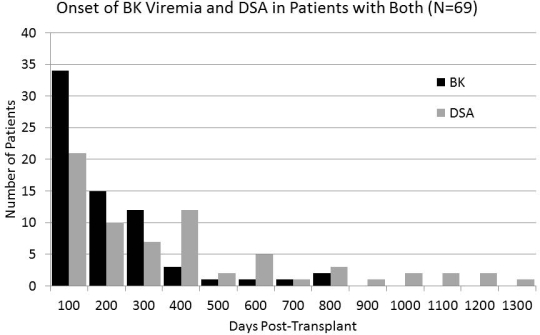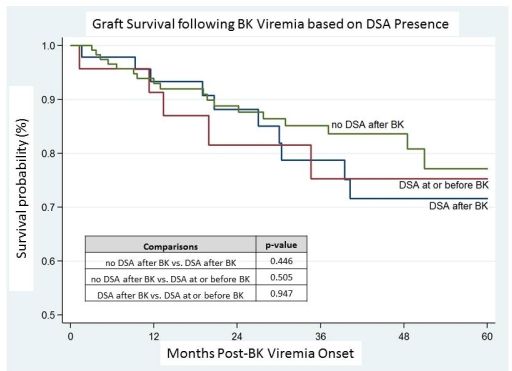Incidence and Factors Associated with De Novo DSA After BK Viremia in Renal Transplant Recipients.
Houston Methodist Hospital, Houston, TX.
Meeting: 2016 American Transplant Congress
Abstract number: D221
Keywords: Antibodies, HLA antibodies, Infection, Polyma virus
Session Information
Session Name: Poster Session D: Polyomavirus
Session Type: Poster Session
Date: Tuesday, June 14, 2016
Session Time: 6:00pm-7:00pm
 Presentation Time: 6:00pm-7:00pm
Presentation Time: 6:00pm-7:00pm
Location: Halls C&D
Recent literature indicates an elevated rate of de novo DSA (dnDSA) following BK viremia (BKV) in renal transplant recipients (RTR). We sought to review our experience in the setting of routine BKV and DSA monitoring and to determine risk factors for dnDSA following BKV. RTR from 2007 to May 2014 were reviewed. Those with immediate graft loss and pre-existing DSA were excluded. BKV+ patients underwent reduction of tacrolimus to levels of <6 ng/mL and mycophenolate to 1 g/day or less. 1019 RTR with a mean follow-up of 44 months were reviewed. Baseline characteristics included a mean age of 50±14 years, 60% male, 60% deceased donor recipients, and 26% African American (AA) race. 62% received ATG induction while immunosuppression consisted primarily of tacrolimus (99%), mycophenolate (99%) and prednisone (89%). 185 (18%) RTR developed BKV at a median of 107 (IQR 82-205) days. dnDSA occurred in 283 (28%) RTR at a median of 272 (IQR 62-575) days. dnDSA occurred in 214 (26%) BKV– and 69 (37%) BKV+ RTR (p=0.002). Of the 69 RTR with both BKV and DSA, 46 developed dnDSA after BKV onset. Thus, 46/162 (28%) of previously dnDSA– patients became dnDSA+ after BKV onset (BKV+/DSA+) at a median of 232 (IQR 119-460) days post-BKV. BKV+/DSA+ patients were younger (50 vs. 54 yrs; p=0.12), more often AA (38% vs. 25%; p=0.10), and had greater HLA mismatches (4.8 vs. 4.0; p=0.002) compared to BKV+/DSA- patients. BKV+/DSA+ patients were more likely to have very high peak viral loads (>6 log10copies, 24% vs 10%; p=0.03), yet were also more likely to clear BKV (98% vs. 77%; p=0.002). Graft survival did not differ between BKV+/DSA+ and BKV+/DSA–, including those with dnDSA prior to BKV. Our experience suggests the frequency and risk factors for dnDSA after BKV (i.e. race and HLA-matching) are similar to those in BKV– patients.

CITATION INFORMATION: Patel S, Kuten S, Knight R, Nguyen D, Graviss E, Gaber A. Incidence and Factors Associated with De Novo DSA After BK Viremia in Renal Transplant Recipients. Am J Transplant. 2016;16 (suppl 3).
To cite this abstract in AMA style:
Patel S, Kuten S, Knight R, Nguyen D, Graviss E, Gaber A. Incidence and Factors Associated with De Novo DSA After BK Viremia in Renal Transplant Recipients. [abstract]. Am J Transplant. 2016; 16 (suppl 3). https://atcmeetingabstracts.com/abstract/incidence-and-factors-associated-with-de-novo-dsa-after-bk-viremia-in-renal-transplant-recipients/. Accessed December 19, 2025.« Back to 2016 American Transplant Congress
